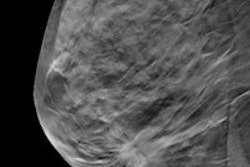
Add another thing to like about digital breast tomosynthesis (DBT): Not only does it find more cancers than digital mammography alone and reduce recall rates, it's cost-effective, according to a presentation at the recent American Roentgen Ray Society (ARRS) meeting in Los Angeles.
Why? Because it reduces the number of exams categorized as BI-RADS 3, or "probably benign," which tend to require short-term follow-up over at least two years, presenter Dr. Madhavi Raghu of Yale University told AuntMinnie.com.
"DBT prompts dramatic decreases in those cases categorized as BI-RADS 3, which in turn reduces the cost of breast cancer diagnosis and follow-up," she said.
Quality of life
A country's "cost-effectiveness threshold" represents its willingness to pay for healthcare interventions. For years, this has been measured in the U.S. in part by the arbitrarily-set figure of $50,000 per quality-adjusted life year (QALY), with one QALY representing a year of perfect health; medical interventions at a dollar value higher than this level are considered less efficient.
 Dr. Madhavi Raghu of Yale University.
Dr. Madhavi Raghu of Yale University.However, in the past decade, researchers have argued that a $100,000 per QALY ratio is more accurate, and this is the figure that Raghu and colleagues used to analyze DBT's effectiveness, in conjunction with the incremental cost-effectiveness ratio (ICER) measure. ICER is defined as the difference in cost between two possible interventions, divided by the difference in their effect.
The team searched Yale's breast imaging database for all diagnostic mammograms performed with 2D mammography between June 2010 and June 2011 and those performed with 2D plus tomosynthesis between January 2014 and January 2015, which was actually Yale's third year of DBT implementation. Raghu and colleagues then compared BI-RADS final assessment categories from these studies, analyzing any associated cost shifts.
"We used data from the 2D group and that third year of DBT because we wanted the comparison to be clean," she told AuntMinnie.com. "Then we analyzed the data by age groups."
Three years after Yale had implemented DBT, there was a 50% reduction in cases classified as BI-RADS 3 and a 30% increase in BI-RADS 1 (negative) and 2 (benign) assessments, the researchers found.
"Our analysis showed that DBT would remain the more optimal diagnostic tool if it resulted in an absolute reduction of 7% or more in the proportion of exams categorized as BI-RADS 3 -- clearly evident in our results," Raghu said.
These shifts in BI-RADS final assessments had a favorable ICER ratio in the overall population and for patients older than 40 years: $51,076 per quality-adjusted life year, much lower than the $100,000 threshold, she told session attendees.
The team's subgroup analysis also confirmed that DBT was cost-effective across different age groups, based on the incremental cost-effectiveness ratio:
- Ages 40-49: $56,550 per quality-adjusted life year
- Ages 50-59: $39,522 per quality-adjusted life year
- Ages 60-69: $87,500 per quality-adjusted life year
- Ages 70-79: $17,178 per quality-adjusted life year
More pros than cons?
The study findings add yet another line item to the "pro" side of a DBT cost-benefit analysis, Raghu concluded.
"The technology significantly reduces the cost of patients returning for diagnostic mammography, by reducing the number of exams categorized as BI-RADS 3," she said. "When we can shift these patients into the BI-RADS 1 or 2 categories, not only is that good for patients, but it's a huge savings."



















